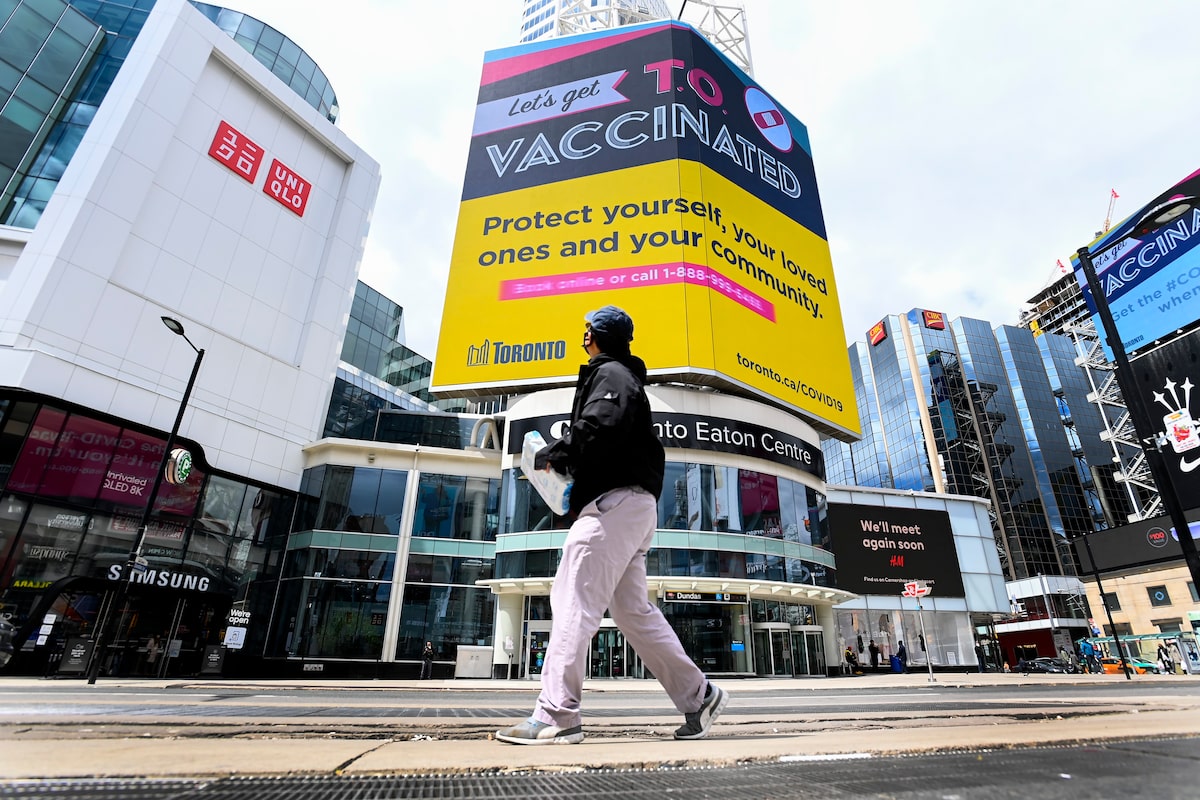A man looks up at a sign in downtown Toronto urging people to get the COVID-19 vaccine, on May 11, 2021.Nathan Denette/The Canadian Press
At the height of the COVID-19 pandemic, anthropologist Heidi Larson and her team at the Global Listening Project conducted dozens of in-depth interviews and focus groups with people in six major cities to learn of their experiences.
By this point, in late 2022, there had been much attention paid by scholars to government responses, virus surveillance and supply chain management, but little to people themselves. She wondered: What are they thinking and feeling, and how might we better prepare society for times of crisis?
In Delhi, respondents said their No. 1 concern was the effect that lockdowns were having on their finances. In New York, it was overwhelmingly mental-health struggles. In Sao Paulo, people spoke of strained relationships, breakups and divorces.
It struck Prof. Larson that no one said their biggest worry was the virus.
“I think that’s a really important message, that unless we hear and listen to people’s priority concerns and address them, or at least acknowledge them, we will not build trust,” she told a forum of public-health professionals on Wednesday.
Opinion: Mistrust in medicine is infecting our society – and it’s putting our children at risk
Prof. Larson, who studies risk and decision science at the London School of Hygiene and Tropical Medicine and co-founded the Vaccine Confidence Project research group, was presenting virtually at the University of British Columbia Centre for Disease Control’s Global Health Security Forum in Vancouver.
Organized in partnership with the BC Centre for Disease Control and the Pacific Public Health Foundation, the event convened public-health leaders from around the world to discuss critical issues in global health security, including tackling misinformation, pandemic preparedness and Indigenous-led public-health approaches.
Across several speakers, a common theme emerged: A public’s willingness to co-operate with health interventions boils down to trust – in institutions, governments and each other.
Tara Kirk Sell, second left, a senior scholar at the Johns Hopkins Center for Health Security in Baltimore, speaks at the Global Health Security Forum in Vancouver on Nov. 5. Dr. Sell said institutions should anticipate the spread of misinformation during times of crisis and equip public-health communicators with resources.Martin Dee/Supplied
Prof. Larson said the pandemic could have been an opportunity to build societal support for vaccines by showing their effectiveness in the face of a highly fatal outbreak. Instead, it had the opposite effect because many people felt that they were being forced to vaccinate in order to enter restaurants, travel or retain their employment.
“Some of them actually resented it, and it didn’t build trust,” Prof. Larson said. “In fact, it took a toll on trust.”
Citing a vaccine confidence index her research group has maintained since 2015, she told the audience that 52 out of 55 countries showed a “not insignificant drop” in the perceived importance of routine childhood vaccines after the pandemic – a knock-on effect that has also been shown in other research.
In the keynote address, Maria Van Kerkhove, who served as one of the faces of the World Health Organization in countless news conferences during the pandemic, spoke of the challenges in communicating to the public evolving science with many unknowns.
She also spoke of the difference between evidence-based guidance, which is informed by science, and policy guidance, which takes into consideration other factors such as an intervention’s impact on the economy and the population’s mental well-being.
“That was really challenging to communicate during COVID because we were all looking at the same data and the policies were different everywhere, for different reasons,” said Dr. Kerkhove, who is now acting director at the WHO’s Department of Epidemic and Pandemic Preparedness and Prevention.
Preparing for the next pandemic must include strengthening global research capabilities, enhancing public-health intelligence and building resilient communities with strong primary health care systems, she said.
Tara Kirk Sell, a senior scholar at the Johns Hopkins Center for Health Security, presented on strategies for tackling misinformation. She spoke of lessons learned during the West Africa Ebola epidemic, and the finding that misinformation was not always about the disease itself, but rather it leveraged the crisis as a vehicle for other agendas.
“It was about these social, political, financial goals that were sort of hopping on the already moving communication vehicle of the Ebola crisis,” she said.
In times of heightened uncertainty, Dr. Sell said institutions should anticipate misinformation and equip public-health communicators with resources. She also cited the importance of trusted messengers – a pastor or influential community member may resonate more than a health professional – and being honest when something isn’t known.
Speakers at the event also covered a number of other threats to global health. Erica Pan, director and state public-health officer for the California Department of Public Health, said she is worried by the Trump administration’s promulgation of “the opposite of gold standard science.” Dr. Pan, whose state recently formed a public-health alliance with Oregon and Washington State in response to federal actions, said there is a need for health to diversify beyond government.
B.C. Provincial Health Officer Bonnie Henry said she is concerned by the polarization of health communication on social media, where young people are drawn into echo chambers and reasonable people are drowned out with hate.
Shannon Waters, B.C.’s deputy provincial health officer of planetary and water health, spoke of the need to decentralize humans when considering global health because of the interconnectedness of humans, animals and the environment.
“If we’re only protecting humans, we’re protecting nothing at all,” she said.

